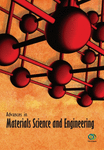Bond Model of Second- and Third-Harmonic Generation in Body- and Face-Centered Crystal Structures
Abstract
In this work, we describe the third- and fourth-rank tensors of body- and face-centered cubic systems and derive the s- and p-polarized SHG far field using the simplified bond-hyperpolarizability model. We also briefly discuss bulk nonlinear sources in such structures: quadrupole contribution, spatial dispersion, electric-field second-harmonic generation, and third-harmonic generation, deriving the corresponding fourth rank tensor. We show that all the third- and fourth-rank tensorial elements require only one independent fitting parameter.
1. Introduction
Surface characterization using nonlinear methods offers several advantages due to its nondestructive nature and the ability to investigate many industrial processes in real-time and nonvacuum conditions. In the past, a comprehensive understanding up to the microscopic atomic level of the measured second-harmonic generation (SHG) data—even for low symmetry samples such as diamond lattices—was difficult because surfaces, in their full complexity, are described by a third-rank tensor with up to 27 complex and 81 complex components if using second- and third-harmonic generations, respectively [1, 2]. In a series of papers, Powell et al. [3], Peng et al. [4], and Adles and Aspnes [5] have argued consistently that azimuthal measurements of rotated silicon samples using higher harmonics can be described by the so-called simplified bond-hyperpolarizabilty model (SBHM). The first major finding was that the then available SHG data for Si(111) in Reference [6] could be well fitted by just using two complex parameters, the “up” hyperpolarizibility used for the upward pointing bond and the “down” hyperpolarizibility used for the three downward pointing bonds. Just using these two complex parameters is a major advantage compared to previous phenomenological description for the same case [7–9]. Later on, SBHM was applied to model surface rotational anisotropy (RA) SHG experiment for a nonvicinal Si(111) surface with success [10] although it has recently been shown by using arbitrary input polarization that bulk quadrupolar effects also contribute to SHG [11]. However, SBHM was also criticised and tested against experiment by using Si(111) with different offcut directions and different offcut magnitude [12].
It turned out that the influence of steps due to the miscut is important. In our understanding, this counter argument is not fair because it is well known that steps induce a major effect for the Si(111) case, and therefore, at least a third parameter should be added, only describing the C2 rotational symmetry of samples with steps as mentioned correctly by McGilp. Indeed when this parameter is inserted, SBHM simulation can be applied to study the variations of the RASHG intensity peak upon changes in the surface vicinality as small as 1° [13]. In a response, Adles and Aspnes included effects like retardation, spatial dispersion, and magnetic effects, proportional to quadrupole contributions in addition to the anharmonic restoring force acting on the bond charge [5]. This inclusion, however, enhances the number of freely fittable parameters, and its strictness and simplicity is thereby lost.
Another important step towards the understanding of SHG in diamond and zincblende lattices was the investigation of the third-rank susceptibility tensor that was obtained from the simplified bond-hyperpolarizability model (SBHM) and group theory (GT) [14, 15], where it was shown that one can derive from GT the SBHM tensor. The work was later extended to show that the model can fit electric-field-induced second-harmonic (EFISH) experimental results in metal-Oxide semiconductor (MOS) with good accuracy [16]. Further test upon the validity of SBHM to model experimental RASHG data from zincblende samples which are noncentrosymmetric confirmed the existence of bulk dipole radiation as the dominant source of SHG [17].
2. Basic Theory
- (i)
The system consists of (partial) charges localized in bonds, and the applied field E causes a displacement of the charge at each bond site only along the bond.
- (ii)
Using Newton’s equation of motion, the induced dipole oscillates harmonically and anharmonically with time under the action of the applied electric field and appropriate restoring and dissipation forces.
- (iii)
The number of bonds is determined by the amount of the next nearest neighbors; thus, there are eight bonds for bcc and twelve bonds for fcc, originating at each atom.
- (iv)
The nonlinear part of motion is summarized in terms of complex hyperpolarizabilities that can be obtained by solving the equation of motion.
- (v)
In classical physics, each accelerated charge radiates, and the far field is calculated as the superposition of the fields radiated by each dipole.
- (vi)
An additional consideration which has not been described in Reference [3] is the coherent superposition of all atomic dipoles. These, by the external fundamental field coherently driven dipoles, radiate in phase, the fundamental as well as the second-harmonic output. Because the distance between the dipoles is much smaller than the wavelength, the coherent superposition leads the angle of incidence (AOI) equal to angle of excidence (θo = θi). This can be explained from the Huygens principle: constructive interference or coherent superposition (equal phase plane) from all radiating dipoles in reflection/transmission is always directed at an angle equal to the AOI angle (Figure 1, which also depicts the applied coordinate system in this work) and the field interferes destructively for all other angles. Also in transmission, a coherent superposition occurs, but it should be noted that usually , both determined by the dispersion relation, respectively, Snell’s law.
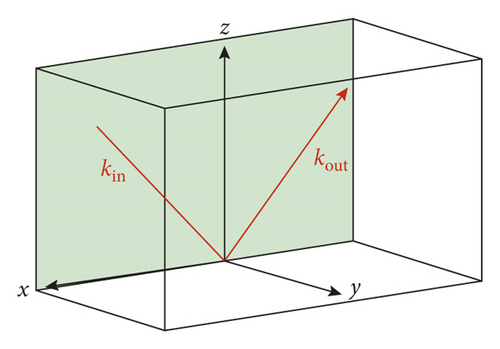

At this point, we would like to address several important limitations of our SBHM because exact expression of the local fields Eloc(ω) and hyperpolarizabilities are not actually calculated, and the latter requires ab initio quantum mechanical calculation which lies beyond the scope of our model and is simply treated as a fitting parameter. It has been shown by Mendoza and Mochán that the nonlinear susceptibility can be written in terms of the linear polarizability at the fundamental and second-harmonic frequencies [21, 22]. In addition, they have also shown comprehensively in their study about local fields of SHG spectra in Si surfaces [21] that the local field also depends on surface modification such as surface reconstruction and relaxation which we ignore in our model. Another limitation in our SBHM is that we assume the nonlinear second- and third-order susceptibilities to be off-resonance so that they are independent of the frequency and therefore obey the Kleinman symmetry. This assumption needs to be emphasized because resonant SHG radiation experiments from Si surface shows that the SH intensity peak does not arise from dipolar SH transition but indeed from the large uncompensated local-field gradient at the surface as shown convincingly in Reference [21]. It is remarkable that they also develop an exactly solvable model for surface SHG consisting of a semi-infinite system made up of a continuous distribution of harmonic polarizable entities, each of which responds nonlinearly to the gradient of the local field prior to the development of SBHM [23]. Nevertheless, our results may be useful as a first approximation to the response of fcc and bcc crystals, and as will be shown, it requires using only a few number of parameters.
Equation (8) describes the radiation of an arbitrary number of dipoles located in the origin. A possible phase difference between radiated fields of different bonds is reasonably neglected because λ is large against the distance between the nucleus and the bond. Within a typical wavelength, however, there are ∼104 atoms, which are coherently driven by the incoming fundamental field. Their phases, e.g., different due to a nonzero angle of incidence, have to be taken into account and second-harmonic radiation of the dipoles has to be added coherently. Despite a single dipole radiates in all the solid angle θi ≠ θo (with the exception of the bond direction), using the Huygens principle however, leads immediately, by considering the phases of the coherently radiating atomic dipoles, to one transmission and reflection direction. The coherent back radiation into air at an AOI = θ for the harmonic wave is the same as for the fundamental one, and the forward radiation into the substrate is determined by the dispersion relation for ε(2ω).
The s and p polarizations of the incoming and outgoing beams lead to four combinations labeled p-p, p-s, s-p, and s-s, where the first and second letters refer to the polarizations of the incident and emerging beams, respectively. The incoming s- and p-polarized beams are given by and .
In our contribution, we critically extend the SBHM to calculate the third- and fourth-rank tensors of body-centered cubic (bcc) and face-centered cubic (fcc) lattices. Furthermore, a single dipole radiates in all the solid angles (with the exception of the bond direction) such that according to Reference [3], the SHG radiation should be measureable in all the upper and lower half spaces. Using the Huygens principle, however, leads immediately, by considering the phases of the radiating atomic dipoles, which are driven coherently by the fundamental field, to the fact that SHG radiation of a stratified layer is only allowed into one transmission and reflection direction.
3. FCC and BCC Surface Response
In this section, we apply SBHM to predict SHG response from the surface of body-centered cubic (bcc) and face-centered cubic (fcc) crystal structures. We are aware that SBHM will be problematic for most metals exhibiting this crystal structure because comparison between SHG intensity from metal surfaces with the SBHM profile will produce different results due to the existence of free electrons in metal therefore exceeding contributions from the bounded dipoles along the bonds. However for nonmetal crystals with fcc and bcc structures such as certain chalcogenide semiconductors, SBHM should produce a good approximation of the SHG far field that is reflected from the surface. The bond orientations for the (001), (110), and (111) surfaces of a bcc crystal is presented in Figure 2.
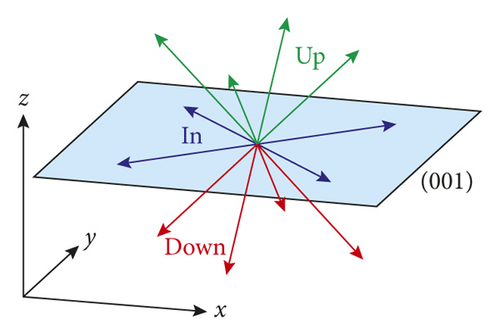
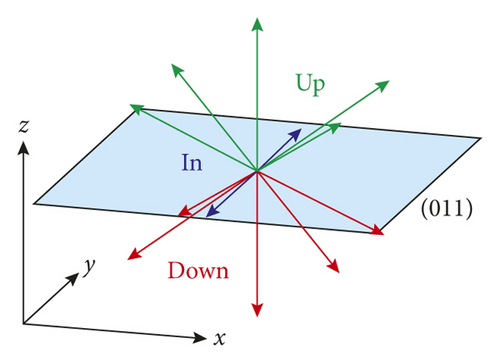
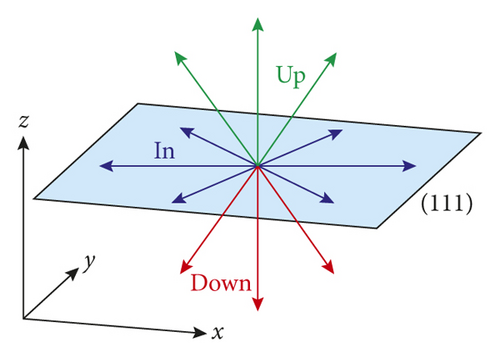
It can be seen from symmetry consideration that if the up and down hyperpolarizabilities are the same, bcc crystals will not produce any SHG far field as can be seen by the formulas above. Thus in the bulk where the hyperpolarizabilities are equal, no SHG signal will appear, and the upper and lower bond dipole radiations cancel each other out.
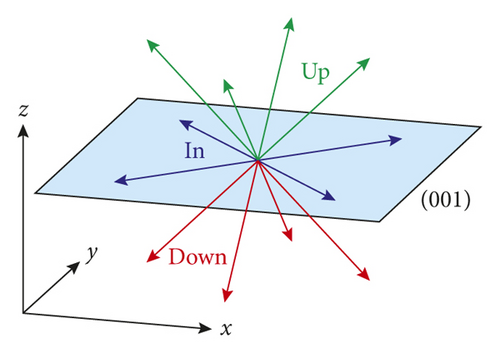
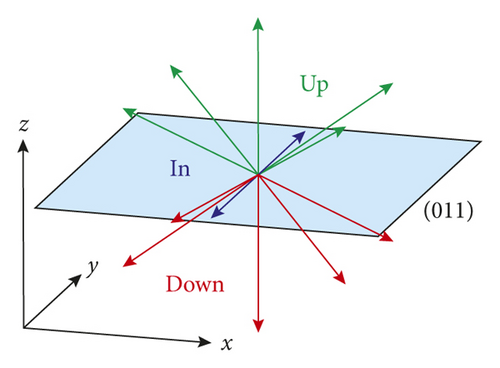
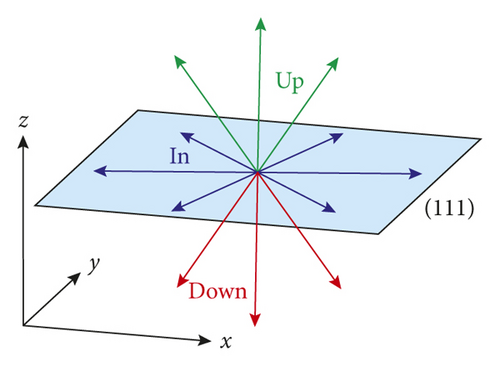
As in the case of the bcc surface, SBHM restricts the fcc surface tensors to have only one independent element which is the effective hyperpolarizability αeff. The interface hyperpolarizability αint cancels each other out and vanishes.
Again, we can easily see from the obtained formulas that if the up and down hyperpolarizabilities are equal, αeff = 0 and a fcc bulk will not produce any dipolar SHG signal, and thus as in the case of bcc, no SHG can arise from the bulk of a fcc crystal.
4. BCC and FCC Bulk Response
Remarkably, SBHM only demands—again—one independent parameter inside the fourth-rank tensor. We note here that the Kleinman symmetry is fulfilled for the three bcc bulk orientation, and this is in agreement with the inherent assumption of SBHM [24].
The fcc (111) bulk fourth rank tensor can be obtained similarly, but it is not depicted here because it is very lengthy. However, it is easy to infer that it also contains only one independent tensor element which is αbulk. It should be noted that the bulk fourth-rank susceptibility tensor to calculate the bulk quadrupole source, spatial dispersion, EFISH, and THG for bcc and fcc crystal structures has the same form because they are defined in Equation (33). However, one should take care of the susceptibility αbulk which is also a function of the frequency as can be seen in Equation (5), so it can be different for different sources and should be fitted experimentally—as is the case of any phenomenology theory.
5. Conclusion
We have calculated the bcc and fcc third-rank surface susceptibility tensors and its corresponding far field. In addition, we also discuss its bulk nonlinear effects and calculate its fourth-rank tensor. It is remarkable to see that the high-restriction SBHM imposes on both the bcc and fcc surfaces as well as its bulk susceptibility tensors where we have shown that it only requires one independent element to describe SHG and THG radiations in reflection.
Conflicts of Interest
The authors declare that they have no conflicts of interest.
Acknowledgments
This research was supported by the BSLN 2018 grant of the Indonesian Directorate of Research and Higher Education. H.H. would like to thank Kurt Hingerl and the reviewer for their constructive inputs, suggestions, and limitations of our model as well as Martijn de Sterke, Husin Alatas, and Benjamin J. Eggleton for valuable discussion about SHG.
Open Research
Data Availability
The [Mathematica.nb] data used to support the findings of this study are available from the corresponding author upon request.



